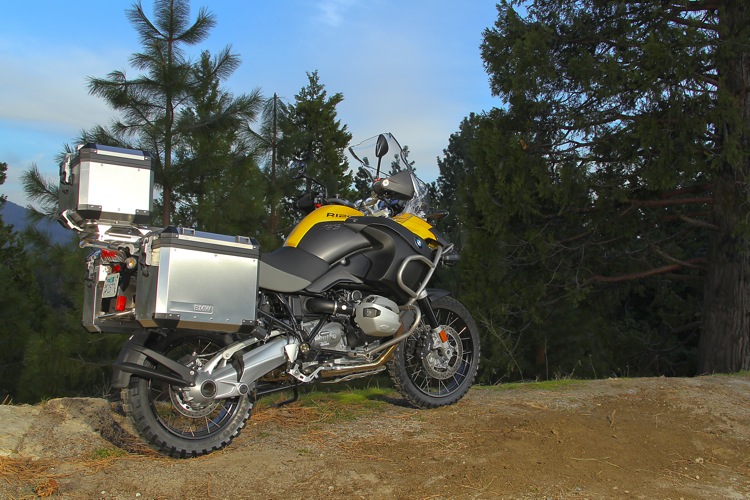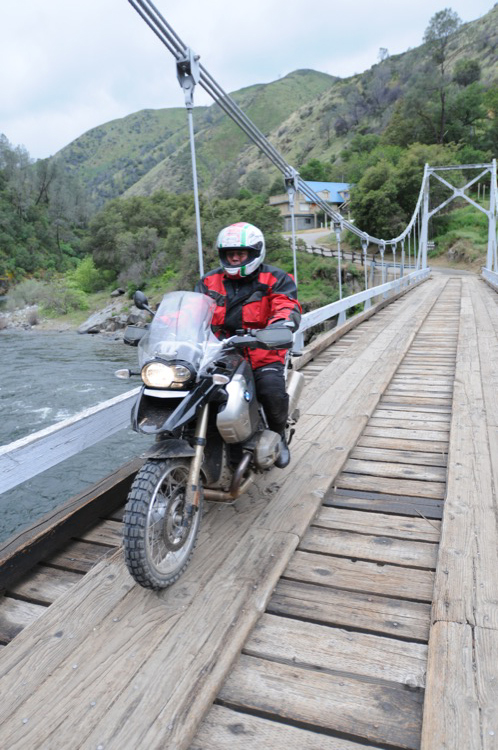2010 BMW R 1200 GS & GS Adventure

BMW Motorrad celebrated the 30th anniversary of its popular GS series by introducing the most powerful R 1200 GS and GS Adventure ever. Taking its name from a combination of the German Gelände and Strasse, GS translates to "terrain" and "road," respectively - and for three decades, GS models have enabled owners to ride to the ends of the earth.
Our test ride was held in and around northern California's fabulous Yosemite National Park. Just as we arrived, a late-spring storm rolled through the Sierra Nevada Mountains, bringing unseasonably cold weather, heavy rains and even snow. Our route took us over a wide variety of terrain, including muddy dirt roads and rutted-out trails, steep climbs and descents, and even some high-speed highway sections with long straights combined with twisty switchbacks.
Drivetrain

BMW's latest GS models both share an upgraded engine with more horsepower and torque, along with aesthetic enhancements, new colors and options. According to BMW, the company spends more on research and development than any other motorcycle manufacturer in the world.
The new engine now has double-overhead cams (DOHC) based on the HP2 model, for increased output of 110 horsepower (+5hp) at 7,500 rpm and peak torque of 88 lb-ft (+3 lb-ft) at 6,000 rpm. The redline has also been raised by 500 revs to 8,500 rpm.
A radial valve arrangement uses larger valves, new intake manifolds, a higher-flow air filter and larger throttle manifold for more airflow. New pistons match the modified combustion chambers, and sodium-filled exhaust valves improve cooling. A new electronically controlled exhaust flap and revised muffler interior further improve breathing. Externally, the new engine is nearly identical to the prior one, except for the two valve cover bolts on each side - the previous model had four bolts per cover.
On our test ride, the fuel-injected engine started right up, warm or cold, and ran smoothly and strongly, even at mile-high elevations. There's a palpable boost in mid-range and top-end pull without any obvious loss in bottom-end torque. In fact, just a quick snap of the throttle wrist will bring the front end off the ground in first gear without any clutch popping.
As before, power is transmitted by the proven, smooth shifting six-speed gearbox. The only difference between models is that the Adventure has a 9% shorter first gear, which helps on steep off-road sections. The clutch and maintenance-free shaft drive to the rear wheel also remain unchanged.
Chassis
The Adventure appears larger because of its 8.7-gallon fuel tank, engine and hand guards, and larger windscreen. A wet weight difference of 60 pounds, plus the added mass of the additional 3.4 gallons of fuel sloshing around up high, makes the R 1200 GS feel peppier and more nimble than the portly Adventure.

A two-section tubular steel frame is comprised of front and rear subframes that use the engine as a load-bearing member. Up front a Telelever fork setup with 41mm stanchions and a five-way adjustable preload carries the weight without diving under hard braking. In back, an aluminum Paralever single-sided swingarm offers stepless preload settings via a handwheel, along with rebound adjustment. The Adventure comes with suspension travel that is .8 inch longer, at both ends, than the standard GS. Long travel and good design result in a plush, yet controllable ride that few other bikes can rival.
Twin front brake rotors clamped by four-piston calipers along with a single rear disc and two-pot caliper handle braking chores. There's strong stopping power with good feedback in front, but the rear brake pedal is difficult to reach.
BMW's GS series continues to offer Enduro ESA, which provides an electrically adjustable suspension that allows the rider to tailor the ride to conditions and even increase ground clearance if needed, with 15 different preload and damping settings ranging from solo to fully-loaded with pillion and off-road. Automatic Stability Control (ASC) limits rear wheelspin and is switchable. There's also optional anti-lock braking (ABS) for safer stops in difficult street conditions, and it can be switched off for dirt riding.
Fortunately for us, BMW had fitted both GS versions with Metzeler Karoo knobbies (normally only found on the Adventure model) on the 19-inch front and 17-inch rear wheels. They offer a decent compromise of on- and off-road grip, and on dry roads warn the rider with a slight howl when they're about to give up, but don't push them too hard cornering on wet pavement. The ASC helped the tires find purchase on the uphill sections and the ABS helped considerably in the rain and snow on paved sections. I wish BMW would develop an ABS system that has off-road settings like some of the 4x4 manufacturers have introduced.
Ergonomics and Features
A new optional additional headlight with LED technology provides brighter illumination with low power consumption. There's also new instrument panel graphics and improved windscreen adjustment, plus new brake and clutch fluid reservoirs. Brake and clutch levers are both adjustable. The heated handgrips are great for cold-weather riding (we got to use them extensively), along with the freeze warning and ambient temperature indicators.

Both models have adjustable seat heights, with 33.5 to 34.2 inches on the GS; BMW offers a lower 32.3-inch seat as a free option, and with the optional lowered suspension, it's 31 inches. The Adventure's 35-inch seat height and its extra fuel weight up high make it difficult to handle for folks who are under about 6-feet tall.
The designs of the R 1200 GS and the R 1200 GS Adventure make it easy to add panniers to the bike. Luggage options include a Vario topcase and metal side boxes, large 13.5-gallon or small 5-gallon soft bags, and a waterproof tankbag.
Final Thoughts
BMW's R 1200 GS series is well made and over time has demonstrated its toughness and popularity, garnering 30% of BMW's sales. Starting at 15 and 17 grand, they're not cheap, but come trade-in time, their excellent resale value will help recoup some of your investment. And if you're bucks up, a special 30th anniversary version will be available in Alpine White with three-color graphics and an embroidered saddle for an additional $ 795.
Technical Specs
+ cool looking, comfortable, yet rugged
- tall seats, heavy, expensive
Distributor BMW Motorrad USA
MSRP base $ 14,950/ $ 17,000 (plus $ 495 destination fees)
Engine DOHC, 4-valves per cylinder Boxer twin
Displacement 1,170cc
Bore and Stroke 101x73mm
Fuel System BMS-KP electronic fuel injection
Power 110hp (claimed) @7,500rpm, 88lb-ft torque @6,000rpm
Cooling air/oil cooled
Ignition digital-inductive electronic
Transmission 6-speed, hydraulic single-plate dry clutch, shaft drive
Frame steel tubular twin subframes using engine as stressed member
Front Suspension Telelever, central spring strut, 5-position mechanical preload adjustment, 7.5/8.3in travel
Rear Suspension Paralever w/ single-sided swingarm, adj. damping, preload w/ opt. ESA 7.9-in/8.7in travel
Rake/Trail 25.7º/ 4.0in (101mm) /Adventure 26.2º/ 3.8in (96.5mm)
Brakes Front/Rear 110/80-R19/ 150/70-R17
Wet Weight 504lbs (228.6kg) / 564lbs (255.8kg)
Wheelbase GS 59.3in (1,507mm)/ 59.5in (1,511mm)
Seat Height 33.5/35 (851/ 889mm)
Fuel Capacity 5.3gal/ 8.4gal (incl. 1gal res)
Fuel Consumption city/hwy 43.3/ 57.4mpg (claimed)
Colors Ostra Gray, Sapphire Black, Alpine White, Magma Red/Smoke Gray, Brilliant Yellow

















